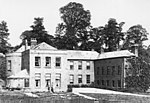Plymstock railway station
1892 establishments in England1961 disestablishments in EnglandDisused railway stations in DevonFormer London and South Western Railway stationsPages with no open date in Infobox station ... and 4 more
Railway stations in Great Britain closed in 1951Railway stations in Great Britain opened in 1892South West England railway station stubsUse British English from September 2020
Plymstock railway station served the suburb of Plymstock, Plymouth, England from 1892 to 1961 on the Plymouth to Yealmpton Branch.
Excerpt from the Wikipedia article Plymstock railway station (License: CC BY-SA 3.0, Authors).Plymstock railway station
Killerton Lane, Plymouth Oreston
Geographical coordinates (GPS) Address Website Nearby Places Show on map
Geographical coordinates (GPS)
| Latitude | Longitude |
|---|---|
| N 50.3671 ° | E -4.1017 ° |
Address
Plymstock Car Sales
Killerton Lane
PL9 7HX Plymouth, Oreston
England, United Kingdom
Open on Google Maps





